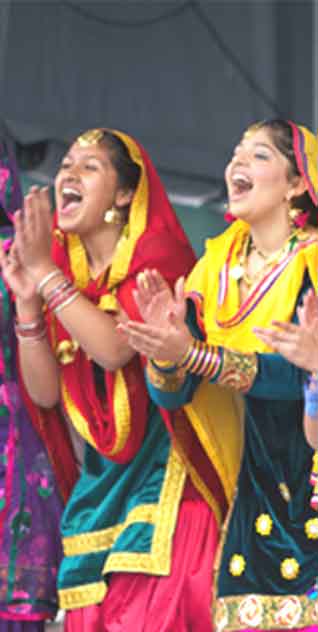Film/Stage
Sikh-Canadian Women Take On Bhangra
LARISSA CAHUTE
Kiran Kaur Mander had no idea her all-girls bhangra team would become a “piece of history.”
In 2001, she and 11 University of British Columbia ("UBC") students in Vancouver, Canada, formed the UBC Girlz bhangra team -- unaware the 15th century Punjabi dance form was historically only performed by men.
“To be honest -- we didn’t know that,” said Kiran, now a board member of the Vancouver International Bhangra Celebration ("VIBC") Society, which kicks off its ninth annual City of Bhangra Festival in Vancouver Thursday, May 30, 2013.
According to Surrey Art Gallery co-curator, Naveen Girn, because of Kiran’s bhangra team, Vancouver has become the “heartbeat for female bhangra dancers.”
“It’s not traditionally a female dance but in Vancouver it really has become (one),” he said.
Traditionally, bhangra was performed by men during the celebration of the Punjabi harvest time, while women were known to perform a dance called giddha done in a “female space” and “not as high energy as bhangra,” said Girn.
So while Vancouver’s bhangra scene dates back to the 1970s, women didn’t start participating until about a decade ago when the UBC Girlz paved the way.
“At the time we just thought we were doing something fun for us,” Kiran said of the all-girls troupe. “We didn’t know that we were creating such an important piece of history.
“For us, it was just normal.”
But as they entered international competitions they were “scrutinized a little bit more.”
“We received feedback from judges that it’s unorthodox for girls to do bhangra, or the moves change when girls do it so it’s not as authentic,” she said. “There was a lot of biases in the judging.
“Even in co-ed teams women were kind of used as props or used for stunts or used for gimmicks … women weren’t really seen as the strong dance figures.”
But the team perservered, unaware of the groundwork they were laying.
“We competed and we would beat guys’ teams,” said Kiran. “We did really well, so that really led the path for us to be accepted.”
By 2005 the UBC Girlz team competed in VIBC’s first-ever City of Bhangra event and took home one of the top prizes.
“It was a fairly phenominal moment,” VIBC Society chair Mo Singh Dhaliwal said of the girls’ big win. “That’s really where it started accelerating.”
And now “it’s almost skewing kind of the opposite way” with more women than men performing bhangra, he said.
“I feel really proud that we made that type of accomplishment,” added Mander. “We really did inspire and touch women to be confident enough to even form teams or to even just participate in this art form.”
And the City of Bhangra Festival has only continued to grow more and more inclusive since its inaugural year.“Our shows really only attracted initially those steeped in bhangra and Punjabi culture,” said Mo Singh. “Whereas our message was to really introduce the music and dance form to a wider audience and bridge culture and bring communities together.”
And in their latest years they’ve done just that, reaching a “far wider” audience, jumping from about 1,800 people at the Centre for Performing Arts for the one-day event in 2005, to about 10,000 people filtering through the 10-day long festival in 2012.
And according to VIBC Society director Sukhi Kaur Ghuman, that reach is the main reason for having the annual festival.
“People can come together regardless of their race or ethnicity and participate and learn about bhangra as well and love it as much as we do,” she said. “Anybody can learn how to bhangra.
“Our goal is to create an event where people have the opportunity to explore their creativity, celebrate culture through particpating in the arts, cross all cultural barriers … just bringing people together to celebrate (the art form).”
VIBC also grew itself from a group of 10 inexperienced volunteers to a board of 10 directors, 30 committee members and up to 100 festival volunteers.
“Now it’s just amazing that almost nine years later we have up to 30 committee members who volunteer year-round (and) we’re actually able to have staff,” said Sukhi. “In year one it was just a one-day event where we held an international bhangra competition and then over the years it has grown from a one-day event, to a weekend event, to a four-day event and in the last few years a 10-day event.”
The festival line-up has also beefed up over the years, with performances by international artists like Finland bhangra band Shava; Portland, Oregon's Dj Anjali and the Incredible Kid and 19-year-old U.K. artist D-Sarb.
The festival kicks off Thursday night at the Fei and Milton Wong Experimental Theatre at Simon Fraser University ("SFU") Woodwards with rePercussion, a musical performance bringing together drums from around the world.
Events run across Vancouver and Surrey until June 8. For more information and event listings, please CLICK here.
[Courtesy: The Province. Edited for sikhchic.com]
May 30, 2013
Conversation about this article
1: Jesse Bateau (Sterling Heights, Michigan, USA), May 30, 2013, 9:04 AM.
This is just great. It is wonderful for women to break through a barrier that has traditionally been held only by men. It may have been done unknowingly, but still it was done, and done well! I love Bhangra, and I could care less if the dancers are men or women. The dance itself is great, high energy, a delight to watch and a great contribution to the world of dance. Keep on doing it. It is a great contribution to the world of dance and dance history as well as a contribution to Bhangra itself.
2: R.Singh (Surrey, British Columbia, Canada), May 30, 2013, 6:27 PM.
In the Malwa district of Punjab, men perform Giddha. So it is about time women did Bhangra.
3: R Singh (Canada), May 30, 2013, 11:43 PM.
Bhangra moves are not exactly female oriented, by the very fact it was performed by males. Giddha is in no way less energetic, only it is more suited to females. With heads covered and traditional salwar-kammez or ghuggra suits and the jewellery, a girl's bhangra is just not as pleasing to the eye. Dance is after all an art form, not merely an acrobatics meet. This, not to take away from the young women, who I am sure are very competent, but dancing need not be a competition, but an expression of joy in an aesthetically pleasing way for either gender.
4: Blighty Singh (London, England), May 31, 2013, 1:21 PM.
Bhangra moves have their origin in the historical symbol of winter in Punjab: the Crane bird, which is mentioned umpteen times in Guru Granth, and in countless Farid and Bulleh Shah poems. The irony here is that due to the neglect of Punjab's environment the famous crane now migrates south to Rajasthan and Haryana rather than Punjab.




